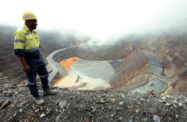A wave of new developments in Papua New Guinea’s (PNG’s) upstream energy sector is under way, including the exploration of new fields and the signing of a deal that could affect the timing of the country’s second liquefied natural gas (LNG) project.
Expanding LNG export capability
The sector’s biggest event this year is set to be the launch of operations at the $19bn ExxonMobil-led PNG-LNG export facility, with the first sales now expected during the second half of 2014. The project, which includes two trains with a combined export capacity of 6.9m tonnes per annum (mtpa), will draw upon fields with reserves of more than 9trn cu feet (tcf) of gas and 200m barrels of associated liquids.
A second LNG export development, the 3.8-mtpa Gulf LNG project, is being spearheaded by Canada-based InterOil, but the facility’s fate remains uncertain in light of a deal the company signed in December with France’s Total. Under the terms of the agreement, the French giant agreed to purchase a 61.3% stake in InterOil’s Petroleum Retention Licence 15, which includes the Elk-Antelope gas fields, as well as the right to develop an LNG export terminal, pending a final investment decision.
While the move to partner with an energy major was expected and indeed required by the government as a condition of its approval for the Gulf LNG project, the choice of Total was coolly received by the markets, and InterOil’s stock fell sharply in December. For much of 2013, investors had speculated InterOil would sign a deal with ExxonMobil to develop the fields, which could have been used to support expansion at the PNG-LNG export facility. Now that Total has signed on – and with no apparent obligation to move forward with the LNG facility – bringing the Elk-Antelope gas to market may prove more challenging, or at the very least, involve delays.
The government, meanwhile, appears eager for quick results. Speaking in January 2014, Minister for Petroleum and Energy William Duma said, “We have seen this project delayed for more than four years since we signed the gas agreement in 2009. We expect InterOil and Total to fast track this project.”
The state’s insistence is related both to growing domestic demand and PNG’s strategic position. The country is well-placed to serve Asian markets, which are expected to lead a 30% increase in global energy use and a 60% increase in demand for LNG by 2040.China, Japan and Taiwan will take delivery of 6.6 mtpa of PNG-LNG’s annual output.
A third major – Anglo-Dutch giant Royal Dutch Shell – is also active in the country and was considered in the running for the Gulf LNG partnership. Having sold its retail and distribution network to InterOil in 2006, Shell re-entered the market in August 2011, signing a deal with then-state mineral and energy arm Petromin Holdings. Under the terms of the agreement the two companies are to carry out a joint study of major basins in the country. However, with the dissolution of Petromin in April 2013, it is unclear how any partnerships will proceed under the aegis of the government’s new energy company, Kumul Petroleum Holding.
New Fields
ExxonMobil and its partners are also heading up ongoing efforts to develop new fields. Oil Search, a local oil and gas company that holds a 29% stake in the PNG-LNG project, is eyeing options for the large-scale exploitation of discovered and undeveloped gas resources at P’nyang, Juha North, Uramu, Barikewa, Kimu, Flinders and Hagana. P’nyang, with an estimated 2.5-3 tcf of gas, may be on-line in 2015, subject to government approval.
Meanwhile, smaller players are moving into the market. China National Offshore Oil Corporation entered through a tie-up with junior exploration outfit UMC Energy, while Australia’s Horizon Oil will bring PNG’s Stanley Gas Project on-line later this year in collaboration with Canada’s Talisman Energy. Downstream products from this operation are likely to be funnelled toward local industry, a growing area of demand that the government is keen to feed.
Indonesia’s state-owned oil and gas company Pertamina has also signalled an interest in the market, signing a memorandum of understanding (MOU) with PNG in mid-2013. The MOU covers cooperation in conducting studies and partnership possibilities, according to a statement by Pertamina.
With PNG’s economy feeling the downturn from the PNG-LNG project’s completion, the prospect of diversified and more numerous oil and gas projects is attractive. At its height in 2012 the PNG-LNG project employed 21,220 and had spent $4bn in-country as of the end of September 2013.
This year is likely to see further support from the government to expedite upstream investments. PNG now has a substantive, skilled labour pool familiar with the demands of conventional LNG technology. Moreover, with the government of Peter O’Neill commanding an absolute majority in Parliament, backed by a popular raft of reforms, PNG has a stable political and fiscal environment. With all eyes on the Asian century ahead, PNG’s energy sector is set to grow.
Follow Oxford Business Group on Facebook, Google+ and Twitter for all the latest Economic News Updates. Or register to receive updates via email.

